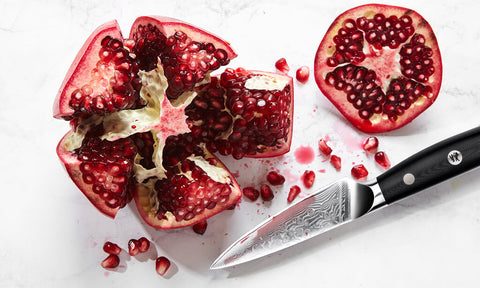
Snowmen aren't the only highlight of winters, but pomegranates share the limelight too. Pomegranates are worth the wait because of their beautiful-looking red arils and juicy taste. But if you're not sure how to cut a pomegranate without creating a mess, it can get frustrating.
If you're wondering how to cut a pomegranate and enjoy every bit of it, you're at the right place. The seeds full of vitamin C, antioxidants, fiber, and other nutritional benefits are safely packed into a thick red cover by nature. Here you'll learn the correct technique to get the jewel-looking red arils out of a pomegranate without making your kitchen look like a murder scene.
What Is A Pomegranate?
Before unfolding how to cut a pomegranate, let's first understand what it is and what its gems contain for us.
Pomegranate is a winter fruit that is available between late October to November. It pretty much looks like a red apple with a flower-shaped stem. It contains small red juicy seeds called arils. They have a sweet-tart flavor and a crunchy texture that tickles the mouth with their juice.
The arils rest inside a soft white interior well packed in a reddish hard exterior. There are hundreds of seeds full of nutrition inside a single pomegranate that can be used in salad, desserts, or mocktails.
Health Benefits Of A Pomegranate
Pomegranates are worth the wait due to their numerous health benefits. Studies have shown pomegranates are among the healthiest fruits on earth. Learning the benefits will make you strive to unfold how to cut a pomegranate without losing a single seed.
Pomegranates are full of nutrition important for healthy living. In a cup full of pomegranate seeds, there are 3 grams of protein, 7 grams of fiber. 30% vitamin C, 16% folate and 12% potassium.
The two most healthy substances Punicalagins and Punicic Acid, are also found in pomegranate. Due to the rich presence of punicalagin, a pomegranate has three times more antioxidants than green tea and red wine.
Regular intake of a pomegranate can also keep you away from heart diseases and cancer. Researchers have found that pomegranate can minimize inflammatory activities in the digestive system and help fight against breast, colon, and prostate cancer through some test-tube studies.
Patients with arthritis and joint pain are also advised to add pomegranate in their routine because pomegranate extract can block enzymes responsible for damaging the joints.
So next time you visit a fruit stall, don't feel skeptical about pomegranate, and give it a shot!
How To Tell If A Pomegranate Is Ripe?
We believe you're convinced to give it a shot and your next thought is to tell if a pomegranate is ripe; we got you covered!
Unfortunately, unlike most fruits, you cannot tell if a pomegranate is ripe or not by looking at its color only. The pomegranate color can vary from pink to dark red, which has nothing to do with the inside. If you're thinking scratches Might help you judge, you're wrong.
According to experts, the correct way to judge if a pomegranate is ripe or not is by holding it. If the pomegranate feels heavy, it means the red jewels inside are ready to be eaten and wise versa. In the case of skin, try to find one with a taut and firm cover.
The best technique to judge if the pomegranate you're purchasing is juicy or not pick up a few so you can compare better. Take all your time to consider the weight because it's better to spend time choosing the right pomegranate than ripping the seeds only to know there's nothing useful and tasteful inside.
How Do You Eat A Pomegranate?
After buying a juicy pomegranate, the next step is to understand how to eat and enjoy it to the fullest. For those who don't know, only the seeds of a pomegranate are edible. The rest is just a safety cover to protect the fruit inside.
The correct way to eat a pomegranate is by ripping the seeds from the white shell inside the thick red covering. You can either add the seeds into your salad directly, add it to your dessert, smoothie, oatmeal, yogurt or make a juice of it to give a sweet-tart flavor to your drinks.
But wait!
In order to eat a pomegranate, you first need to learn how to cut a pomegranate in no time.
How To Cut A Pomegranate: A Step By Step Guide
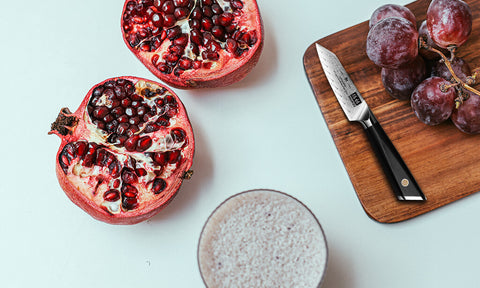
Opening a pomegranate can be messy and time-consuming if you don't have a proper game plan. Here is an effective technique for cutting a pomegranate without making your kitchen look like a crime scene.
Step 1: Cut And Remove The Top
Take a sharp knife and remove the pomegranate top.
Step 2: Make Thin Cuts Along The Ridges
After removing the top, you'll see 5-6 ridges on the surface of the fruit. Because pomegranate is not perfectly round, the number of ridges may vary. Using the same knife, make a partial cut of the fruit along the ridges from top to bottom.
Remember to stick around the red skin and the white part because the aim is to open the pomegranate without cutting the seeds.
Step 3: Pry Open With Your Hands
Use your hands to open the pomegranate in order to take out the seed. To do so, grab the pomegranate between your hands and place both your thumbs in the center of it.
Now gently pull the center apart to end up having separate fruit sections.
Step 4: Pull Out The Seeds
There are two ways to extract the seed out of a pomegranate.
Most people use a wooden spoon, but you can use other utensils to whack out the pomegranate seeds.
If you're concerned about getting hurt or getting your kitchen and counter dirty, this method will work better for you. Remove the seeds with your hands using your fingers from the white part. To avoid staining your clothes, you can do this step underwater.
Step 5: Separate White From The Seeds
Fill a large bowl with water to the level that the arils get soaked properly. Wait till the white pith starts floating at the surface of the water, leaving only the red seeds at the bottom.
Now, strain the seeds.
First, use a filter, take out the white membrane, and then strain the seeds.
How To Make Pomegranate Juice From Pomegranate Seeds
If you're not fond of eating pomegranate due to its seeds, you can switch to pomegranate juice to enjoy its nutritious values. Here is a simple technique for hassle-free pomegranate juice.
Step 1:
Making pomegranate juice is similar to juicing passion fruit. Pour the seeds into a blender and blend it only to break the seeds and don't over blend; otherwise, the small particles will take too much to separate. Also, over blending can hurt the original taste of pomegranate. Hence blend enough to take out the juice from the arils.
Step 2:
Now drain the mixture through a strainer. It might take a few minutes because of the thick pulp blocking the juice. Use a spoon to gently stir the mix, so the liquid doesn't stay back with the pulp.
Tip: Add little water while straining to speed up the process.
Step 3:
Add sugar and water to take or enjoy it as it is.
Delicious Pomegranate Recipes
Pomegranates are versatile fruits that can be used to prepare various tasteful recipes, including desserts, yogurt, mocktails, smoothies, or salad.
§ Mix With Your Salad
In a small skillet, cook some pecans and sugar over medium with constant stirring until you get the caramel color. Put these pecans in a bowl to cool down, then break them into small pieces. Mix these crunchy pecan pieces with pomegranate seeds, lettuce, red onion, and feta cheese. Pour some vinegar, olive oil, lemon juice, salt, and pepper over the salad. Enjoy the delicious blend of salty feta cheese and sweet pomegranates.
§ Add It Into A Smoothie
Blend some pomegranate seeds in a blender until it liquifies. Add some pineapple, banana, Greek yogurt, and maple syrup to it and blend again until a creamy texture is achieved. Enjoy the refreshing smoothie with some ice.
Best Knives To Cut A Pomegranate
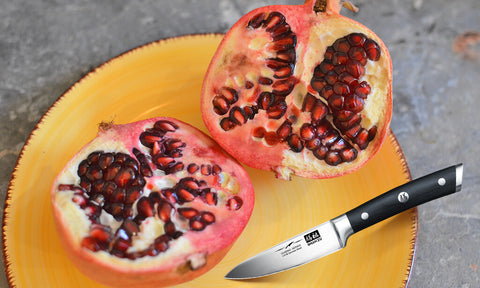
Now that you've learned how to cut a pomegranate, you need a good knife to get into practice. Here are a few of the best knives you can choose from.
Chef's Knife 7"
Features
- Stainless steel
- Medium size
- Light and easy to handle
Pros
- Both right and left-handed people can use it; thanks to the sleek design
- Comfortable grip
- Sharp enough to cut the fruit conveniently
Cons
- The size of the knife will feel big if you're used to working with small blades
- Not a beginners' knife
8″ Chef's Knife
Features
- Stainless steel
- Non-slip handle
- Optimal weight
Pros
- It can be used for both commercial and residential cutting
- Lightweight structure for easy handling
- Dishwasher safe
Cons
- The blade might get dull with time
Paring Knife
Features
- Stainless steel
- Lightweight
- Ergonomic polymer handle
Pros
- Perfect for gentle cuts
- The handle is convenient, and non-slip hence offering extra safety
- Economical
Cons
- The blade might lose its efficiency with time.
10″ Chef's Knife
Features
- Includes carbon
- No stain steel
- Superior resilience
Pros
- Includes a triple rivet handle that offers safe handling
- Dishwasher safe hence easier to maintain
- Sharp enough to cut the fruit conveniently
Cons
- If you're not used to long sharp knives, you need to be extra careful
- A bit expensive as compared to other blades
Frequently Asked Questions About Pomegranates
§ When are pomegranates in season?
Some varieties are available in summers these days, but pomegranate is a mid-season fruit. If you want to enjoy a juicy, tasty, and nutritious pomegranate, you can only find one from October to January.
§ How to pick a pomegranate?
Pomegranates are not very cheap; hence it's good to be cautious while purchasing one. To get the best pomegranate full of juice and red seeds, the first thing is to check its weight. It is said that the heavier a pomegranate, the more the juice inside the seeds.
You can also pick a pomegranate through its skin. Go for the one with firm skin. However, you should focus on the weight more and keep the skin part as a secondary feature.
§ What part of a pomegranate is poisonous?
In general, none of the parts are poisonous unless you eat it in a large amount by mouth. However, the pomegranates' roots, peels, and stems are non-edible and can be unsafe to eat.
§ How do you store pomegranate seeds?
The best part of pomegranate is that its seeds can be stored. Follow the following steps to preserve the red jewels for the next time.
Take an airtight container or a zip bag and pour the seeds inside
Press the size of the bag to ensure there's no air resting in the bag
Put the bag in the refrigerator. You can store arils for about 4-5 days through this technique.
In case you want to keep the seeds for longer:
Use parchment or waxed paper and line it on a sheet pan.
Pour the seeds and freeze them.
§ How to eat a pomegranate?
Only the seeds of the pomegranate are edible. You can either eat the seeds completely or through them after sucking the juice out of them. Use the above technique if you don't know how to cut a pomegranate and take out the seeds.
§ How to store and freeze pomegranate seeds?
Pomegranate seeds can be preserved for weeks and even months through this method.
Take parchment paper or waxed paper and line it on a sheet pan.
Pour the seeds onto it and freeze them to use later.
§ How to juice a pomegranate?
Use the following method for pomegranate juice.
Pour the seeds into a blender and blend it till the seeds break.
Take a strainer and drain the blended mixture to separate the juice from the pulp.
If it takes too long, use a spoon and gently squeeze the juice.
§ What to do with pomegranate seeds?
Pomegranate seeds can be used in a number of recipes. You can use them in your fruit salad for a sweet-tart flavor or add them to your yogurt to enjoy a different taste. Pomegranate seeds can also be used in desserts, mocktails, smoothies, and other drinks.
§ How to know what parts of the pomegranate to eat and what to toss?
Pomegranate is a sum of three main parts:
- Red outer layer
- White inner pits
- Red seeds
Only the red seed resting in the white pits contains the fiber and nutritions; the rest is to be tossed.
It's Pomegranate Time
Pomegranate is both healthy and tasteful only if you know how to cut a pomegranate properly. It is a versatile fruit that can be used in a variety of recipes to enjoy a different flavor out of it.
We hope the above technique on how to cut a pomegranate, the recipes, and the question answers will help you purchase a pomegranate that is worth spending.

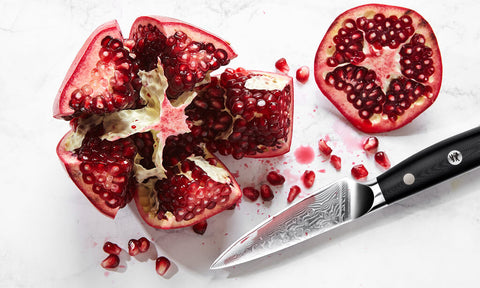

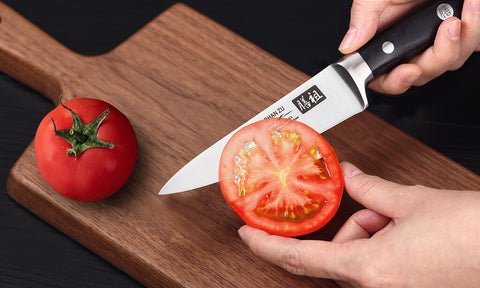

Commentaires (0)
Il n'y a pas de commentaires pour cet article. Soyez le premier à laisser un message !